Oak woodland alive and well in St. Helens
Caroline Skinner, March 18 2015
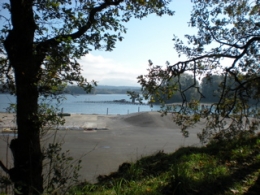 Nob Hill Nature Park is a 6.6-acre oak woodland overlooking the Columbia River and the northern tip of Sauvie Island. Before getting park status from the City of St. Helens, Oregon, in 2008, the land stood neglected and nearly forgotten. It was badly infested with invasive plants. A dead zone full of ivy, holly and blackberry made much of the land impenetrable.
Nob Hill Nature Park is a 6.6-acre oak woodland overlooking the Columbia River and the northern tip of Sauvie Island. Before getting park status from the City of St. Helens, Oregon, in 2008, the land stood neglected and nearly forgotten. It was badly infested with invasive plants. A dead zone full of ivy, holly and blackberry made much of the land impenetrable.
Starting in 2004 with a SOLVE cleanup, followed by a SOLVE ivy pull to 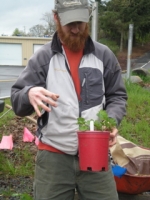 remove vines from trees, a small group of neighbors helped the park's natural environment start to recover. After seeing the seriousness of volunteers, the city granted official park status, and the Friends of Nob Hill have been active stewards there ever since.
remove vines from trees, a small group of neighbors helped the park's natural environment start to recover. After seeing the seriousness of volunteers, the city granted official park status, and the Friends of Nob Hill have been active stewards there ever since.
The park has become a popular place for local residents to enjoy a walk in the woods, and it's a protected place for a bit of Oregon's endangered, diminishing oak habitat.
The Friends group holds semiannual volunteer work parties with the Scappoose Bay Watershed Council to remove English ivy, holly and other invasive plants, including lunaria (sometimes called money plant). The next one is coming up on Saturday, April 4. You can also check things out on a March 21 field trip.
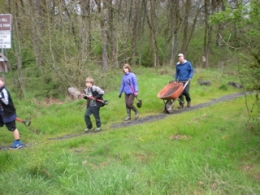 The watershed council generously provides tools and native plants for each work party. Thanks to them, the park received two years of treatment for blackberries, which opened up large new areas. We've replanted there with native plants including willow, spirea, red twig dogwood, vine maple, madrone, cascara, elderberry, yarrow, checkermallow and wild roses. In summer, we water new plantings from a tap provided by the city.
The watershed council generously provides tools and native plants for each work party. Thanks to them, the park received two years of treatment for blackberries, which opened up large new areas. We've replanted there with native plants including willow, spirea, red twig dogwood, vine maple, madrone, cascara, elderberry, yarrow, checkermallow and wild roses. In summer, we water new plantings from a tap provided by the city.
 Other native plants that are easy to find at the park include trillium, viburnum ellipticum, Indian plum, oceanspray, Pacific ninebark, mahonia and chokecherry. With all those berries, it's a good place for bird watching. Flocks of cedar waxwings can be seen on serviceberry in spring, and fish-eating osprey from the nearby river can often be heard calling while flying overhead.
Other native plants that are easy to find at the park include trillium, viburnum ellipticum, Indian plum, oceanspray, Pacific ninebark, mahonia and chokecherry. With all those berries, it's a good place for bird watching. Flocks of cedar waxwings can be seen on serviceberry in spring, and fish-eating osprey from the nearby river can often be heard calling while flying overhead.
Still, non-native and invasive plants threaten the park's ecological health by crowding out all others. One particular area that we call “invasive gulch” has a sad history of yard debris dumping. The area is troubled by the spread of arum, Spanish bluebells, grape hyacinth, cyclamen, lunaria and rocket – all hardy and hard to eradicate. These plants may be great in yards and gardens, but they do not belong in our nature park. They love growing in the gorgeous, rich soil created from decades of composted oak leaves. Ongoing removal by hand-pulling is slow, and help is always welcome.
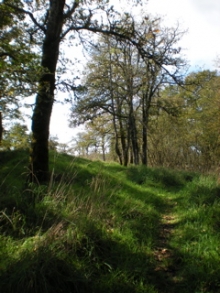 The smothering ivy, for the most part, has been removed from native white oak trees. Future work parties will continue to remove blackberry, as well as pulling more ivy off the ground. Long-range plans could involve work on invasive orchard grass that is spreading rapidly in camas bed areas.
The smothering ivy, for the most part, has been removed from native white oak trees. Future work parties will continue to remove blackberry, as well as pulling more ivy off the ground. Long-range plans could involve work on invasive orchard grass that is spreading rapidly in camas bed areas.
The city's parks department has provided us with several loads of gravel to help stabilize Nob HIll's trail in muddy areas. Two wooden footbridges now take walkers over points where running water crosses the trail in the wet season.
 The hard work is a long way from done, but clearly the park is in much better ecological shape than it has been for years. Native plants are rebounding. Where else can you see such a profusion of fawn lilies in March or fernleaf biscuitroot in May? With mature oak trees and associated understory, it’s possible to catch a glimpse of what natural life was like here long ago, as well as an excellent view of the river.
The hard work is a long way from done, but clearly the park is in much better ecological shape than it has been for years. Native plants are rebounding. Where else can you see such a profusion of fawn lilies in March or fernleaf biscuitroot in May? With mature oak trees and associated understory, it’s possible to catch a glimpse of what natural life was like here long ago, as well as an excellent view of the river.
Check out a short video about the park, part of the “We Are St. Helens” series. And come visit us soon!

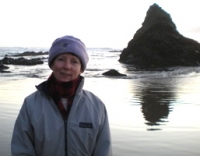 Caroline Skinner is cofounder and steward of Nob Hill Nature Park, along with her partner Howard Blumenthal. She is also an active member of Friends of Baltimore Woods in the St. Johns neighborhood of Portland, and is coordinator of the group’s quarterly e-newsletter. Active in environmental justice and outdoor restoration projects, she has called Oregon home since 1978 and currently lives in North Portland.
Caroline Skinner is cofounder and steward of Nob Hill Nature Park, along with her partner Howard Blumenthal. She is also an active member of Friends of Baltimore Woods in the St. Johns neighborhood of Portland, and is coordinator of the group’s quarterly e-newsletter. Active in environmental justice and outdoor restoration projects, she has called Oregon home since 1978 and currently lives in North Portland.
Comments
Nob Hill Park
Your work
Well done!
Nob Hill
Add new comment